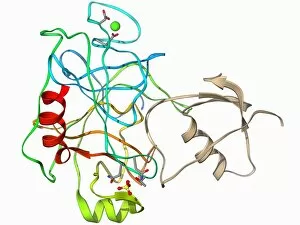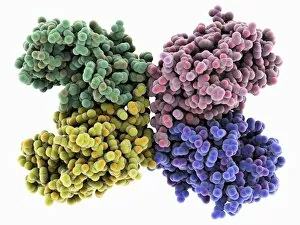Protease Collection
Protease: Unveiling the Molecular World of Enzymatic Power In a realm where molecules dance and interact
All Professionally Made to Order for Quick Shipping
Protease: Unveiling the Molecular World of Enzymatic Power In a realm where molecules dance and interact, protease takes center stage as an essential player in countless biological processes. Conceptual images like that of enterokinase provide us with a glimpse into the intricate world of these powerful enzymes. One such example is HIV-1 protease, depicted alongside its inhibitor F006/9773. This image symbolizes the ongoing battle against this devastating virus, highlighting the importance of understanding proteases for developing effective treatments. Pepsinogen molecule F006/9710 showcases how they can be activated to their active form, pepsin, which aids in breaking down proteins during digestion. Similarly, trypsin molecule F006/9634 demonstrates another digestive enzyme's structure and function. The captivating image featuring trypsin molecule with inhibitor F006/9633 reveals how inhibitors can bind to specific sites on proteases to regulate their activity. Such insights hold promise for designing drugs that target proteases involved in various diseases. Rhomboid protease molecules (F006/9621 and F006/9607) captivate our imagination by showcasing their unique shape and mechanism. These enzymes play crucial roles in cellular signaling pathways and are potential targets for therapeutic interventions. Thrombin protein's molecular model (F006/9603) reminds us of its pivotal role in blood clotting regulation. Understanding thrombin's structure allows scientists to develop anticoagulant drugs with precision. Chymotrypsin digestive enzyme molecule (F006/9577) unravels yet another member of the protease family involved in protein digestion. Its distinct structure highlights its ability to cleave peptide bonds selectively. ATP-dependent protease molecule (F006/9552) stands out due to its reliance on ATP energy source for degradation of damaged or misfolded proteins within cells—a critical process maintaining cellular health.

























